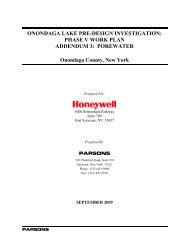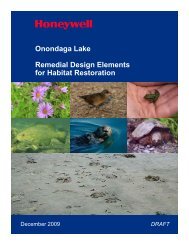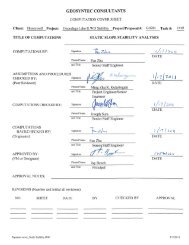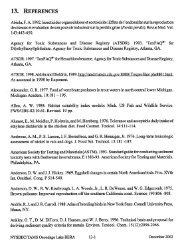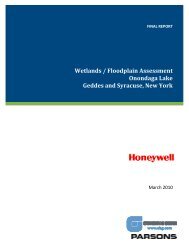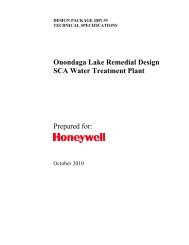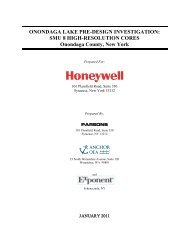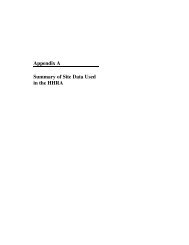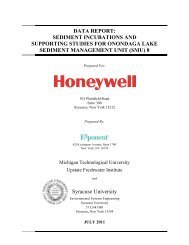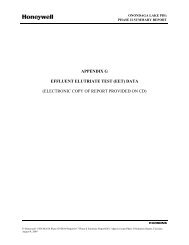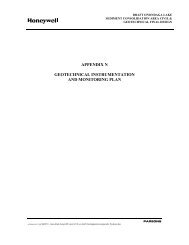Phase 1B Underwater Archaeological Report for the Onondaga ...
Phase 1B Underwater Archaeological Report for the Onondaga ...
Phase 1B Underwater Archaeological Report for the Onondaga ...
You also want an ePaper? Increase the reach of your titles
YUMPU automatically turns print PDFs into web optimized ePapers that Google loves.
FINAL<br />
<strong>Phase</strong> IB <strong>Underwater</strong> <strong>Archaeological</strong> Resources <strong>Report</strong> <strong>for</strong> <strong>Onondaga</strong> Lake Superfund Site<br />
Significance Evaluation<br />
National Register Evaluation<br />
Integrity<br />
of:<br />
Location A33 remains at its original location, thus LCMM recommends that it<br />
retains integrity of location.<br />
Design A33 is likely to retain design elements such as spatial organization,<br />
technology and materials that are reflective of <strong>the</strong> boatbuilders’ original<br />
activities. LCMM recommends that A33 retains integrity of design.<br />
Setting Although A33’s location in <strong>Onondaga</strong> Lake remains <strong>the</strong> same as when it<br />
sank, its specific surroundings have changed significantly. Sedimentation<br />
around and over <strong>the</strong> site has changed <strong>the</strong> adjacent lake bottom,<br />
vegetation and topography. LCMM recommends that A33 does not<br />
retain integrity of setting.<br />
Materials Nearly all of A33 is buried beneath <strong>the</strong> lake bed. Although this makes<br />
<strong>the</strong> assessment of <strong>the</strong> configuration of <strong>the</strong> site difficult, if not<br />
impossible, it is safe to conclude that those materials remain intact.<br />
Moreover, those buried materials will be in a better state of<br />
preservation than those exposed above <strong>the</strong> lakebed. LCMM<br />
recommends that A33 retains integrity of materials.<br />
Workmanship A33 may have significant potential to yield in<strong>for</strong>mation about <strong>the</strong><br />
boatbuilders’ skill and techniques; however this aspect of integrity<br />
cannot be concluded with <strong>the</strong> current data set. LCMM recommends that<br />
A33 may have integrity of workmanship.<br />
Feeling The historic character of A33 is limited by <strong>the</strong> buried nature of <strong>the</strong><br />
archaeological remains. LCMM recommends that A33 does not retain<br />
integrity of feeling.<br />
Association A33 remains in <strong>the</strong> place where <strong>the</strong> sinking occurred and it is sufficiently<br />
intact to convey its nature as a canal boat. From an in<strong>for</strong>mation<br />
potential perspective, integrity of association is measured in terms of<br />
<strong>the</strong> strength of <strong>the</strong> relationship between <strong>the</strong> site’s data and important<br />
research questions. The known archaeological data, although extremely<br />
limited due to <strong>the</strong> buried nature of <strong>the</strong> property, indicates that <strong>the</strong> site<br />
could answer important questions about canal boat construction<br />
materials and techniques, and, if <strong>the</strong> boat sank in distress, canaller<br />
culture and <strong>the</strong> operational use of an Erie Canal Boat. LCMM<br />
recommends that A33 retains integrity of association.<br />
Criterion: A: Event A33 has an association with pattern of events comprising <strong>the</strong><br />
commercial use of <strong>the</strong> New York State Barge Canal. Areas of significance<br />
include commerce and transportation. LCMM recommends that A33 is<br />
eligible under Criterion A.<br />
B: Person No known individually significant persons are associated with <strong>the</strong> A33.<br />
LCMM recommends that A33 is ineligible under Criterion B.<br />
C: Design/<br />
Construction<br />
A33 may be eligible under Criterion C, but <strong>the</strong> lack of archaeological data<br />
makes this conclusion difficult to reach. LCMM recommends that A33 is<br />
D: In<strong>for</strong>mation<br />
Potential<br />
currently ineligible under Criterion C.<br />
The study of A33 is likely to yield in<strong>for</strong>mation about nineteenth century<br />
boatbuilding techniques and, if <strong>the</strong> vessel sank in distress, in<strong>for</strong>mation<br />
172



